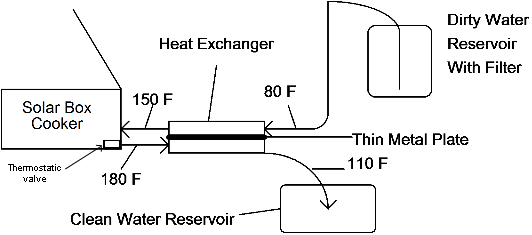APSC100: Project #153: Design for Health in Peru
Preliminary work on the design of a Health Care Centre in Peru found that one of the primary health care problems in Peru is the lack of access to safe drinking water. Although, the water and sanitation sector in Peru has made important advances in the last two decades (including the increase of water access from 30% to 62% between 1980 and 2004 and sanitation access has also increased from 9% to 30% from 1985 to 2004 in rural areas), the majority of people living in rural areas do not have reliable access to safe drinking water. Current issues with water in Peru include contamination with fecal coliforms and poor sanitation. This results in bacterial contamination and sickness. To reduce the number of patients at the Health Care Centre and thus limit the size to meet the low budget – people in the region could be given household-scale solar water pasteurization devices.
Although some people currently boil water, all microbes that cause disease in humans do not survive at temperatures exceeding 65C, which solar devices can easily produce. A flow-through water pasteurizer contains a thermostatic valve that opens when the water reaches a threshold temperature (indicating pasteurization), and the outgoing hot water warms the incoming cool water in a heat exchanger. The flow is caused by the dirty water reservoir being at a higher elevation than the clean water reservoir. The addition of the heat exchanger and the valve increase the output by a factor of eight or more.
See: Background Material
Design Challenge[edit | edit source]
Design a thermostatic valve for the solar water pasteurization systems with the following characteristics:
- Opens at 70C to allow pasteurized water to flow to clean water reservoir
- When below 66C it must close completely and not allow any water (non-pasteurized) to flow to the clean water reservoir.
- Have as few moving parts as possible and be able to work for years opening/closing dozens of times a day
- Be as small as possible – ideally fit in line with a 0.250" I.D. x 0.375" O.D. polycarbonate tube
- MINIMIZE COST!!!!!! MINIMIZE COST!!!!!! MINIMIZE COST!!!!!!
Design Teams[edit | edit source]
- Team A: Mass produced thermostatic valve for water pasteurization - a valve that could be easily mass produced,
- Team B: Locally manufactured thermostatic valve for water pasteurization - a valve that could be made from local materials by local crafts people,
- Team C: Adapted thermostatic valve for water pasteurization - a valve that could fabricated by altering an existing inexpensive device (e.g. automobiles have thermostatic valves)
Include Tag[edit | edit source]
to put this on your pages:
